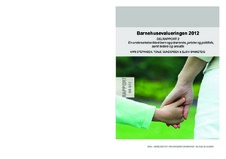| dc.contributor.author | Stefansen, Kari | |
| dc.contributor.author | Gundersen, Tonje | |
| dc.contributor.author | Bakketeig, Elisiv | |
| dc.date.accessioned | 2020-06-07T21:05:54Z | |
| dc.date.accessioned | 2021-04-29T13:59:43Z | |
| dc.date.available | 2020-06-07T21:05:54Z | |
| dc.date.available | 2021-04-29T13:59:43Z | |
| dc.date.issued | 2012 | |
| dc.identifier.isbn | 978-82-7894-434-9 | |
| dc.identifier.issn | 0808-5013 | |
| dc.identifier.uri | https://hdl.handle.net/20.500.12199/3389 | |
| dc.description.abstract | This report presents findings from the first evaluation of the Norwegian equivalent to children’s advocacy centers: Statens barnehus. The evaluation was carried out on behalf of the Police Directorate. A second report from the evaluation is published by the Police Academy (Bakketeig et al. 2012). The Norwegian barnehus model is aimed primarily at police reported incidents of violence and sexual abuse against children under the age of 16. The role of the barnehus staff is to coordinate and facilitate the police interview with the child, to evaluate the child’s need for psyco-social assistance, and to provide short term treatment to those in need. The model aims at reducing the stress of the legal process for children and families, to increase the level of cooperation between professionals and to build and disseminate knowledge about victimized children. This evaluation includes six of the seven centers that exist in Norway, all established from 2007 through 2009. In the report we describe the experiences with the Norwegian barnehus model from the perspectives of children and parents, the police and legal professionals, and staff and administrators. The analysis is based on both interview and survey data. The number of police interviews carried out in a barnehus increased from 2010 to 2011. In 2011 1605 police interviews with children were carried out in the six centers included in the evaluation. In centers with a particularly high increase the work load is experienced as too heavy for the staff. The staffs work can be divided into three phases: the preparation phase, the police interview phase and the follow up phase. All centers carry out important tasks in the three phases, but some pay more attention to all tasks than do others. Our conclusion is that there is a need for guidelines as to what the barnehus staff’s tasks are in different phases and how the different task should be carried out. The centers are administered and financed by the police districts in which they are located. The administrators report that this has worked fine, and that the link to the police system has given the barnehus model a needed legitimacy in the foundation phase. In their view the time has come, however, to rethink this model of organization. We conclude in accordance with the administrators: the current model of organization may work against the aim of a common work standard in cases involving victimized children. Children and accompanying adults give both then barnehus staff and the police interviewers positive evaluations. They feel taken care of, and appreciate the friendly atmosphere at the barnehus. The message from children is that barnehus is a good place for children. The police and legal professionals are also positive in their evaluations of the barnehus model. Children receive good care "under one roof», the staff is competent in children’s issues and they do a good job at taking care of the parents. The downside is the extra time needed to travel to the barnehus. Some also feel that the use of barnehus leads to more weight being put on the best interest of the child than on the legal process. A majority of 70 percent feel, however, that these issues are well balanced. The police and legal professionals were also asked a number of questions regarding the procedure for police interviews. The message from the police and legal professionals is that the current legal regulation should be changed on a number of issues. For instance, a majority of 72 percent stated that barnehus should not be voluntary for the police districts, but used in all relevant cases. All in all we conclude that the aims of the measure are fulfilled. Children who are interviewed by the police at barnehus receive better care than children who are interviewed at the police station or in the local court. The model also leads to a more coordinated effort from the involved professionals both from the legal and medical systems. Our view is that it has lead to increased awareness in the general population and higher competence among professionals as well. Two challenges appear from our analyses however: the increased mismatch between police reported cases and resources at the barnehus and the lack of guidelines for the staffs work. | en |
| dc.description.abstract | Denne evalueringen er gjennomført på oppdrag fra Politidirektoratet, og publiseres som delrapport 2 av Barnehusevalueringen 2012 – den første evalueringen av barnehusenes virksomhet siden de ble etablert. I rapporten belyser vi ordningen med barnehus sett fra ulike aktørers ståsted: barn og pårørende, jurister og politifolk, samt ledere og ansatte ved barnehusene. Overordnet handler rapporten om hvilken betydning innføringen av barnehusmodellen har hatt for ivaretakelsen av barn mistenkt utsatt for vold og seksuelle overgrep, og for koordineringen av arbeidet til aktuelle instanser i slike saker. Rapporten peker også på utfordringer knyttet til barnehusenes virksomhet og den organisatoriske forankringen de har i dag. | no_NB |
| dc.publisher | Oslo Metropolitan University - OsloMet: NOVA | |
| dc.relation.ispartofseries | NOVA Rapport 9/12 | |
| dc.subject | NOVA | |
| dc.title | Barnehusevalueringen 2012 - Delrapport 2 | no_NB |
| dc.type | Report | |
| fagarkivet.author.link | https://www.oslomet.no/om/ansatt/elba | |
| fagarkivet.source.pagenumber | 164 | |
